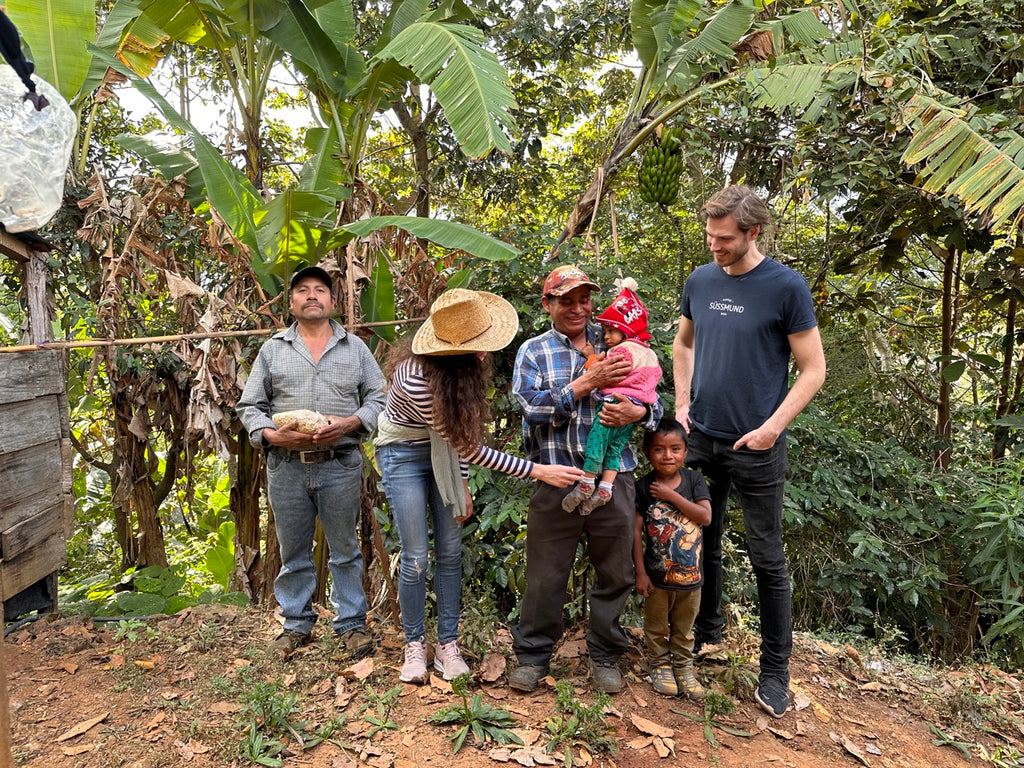A trip to Oaxaca to our organic coffee from Mexico

Mexico is a vast country with a wide variety of vegetation and landscapes. The climate in the arid north and the tropical Yucatan Peninsula is not suitable for coffee cultivation. However, the higher elevations of the states of Veracruz, Oaxaca, and Chiapas offer optimal conditions for coffee cultivation. Here, at elevations of 1,000–2,000 meters, fine Arabica coffee plants grow, which are said to have a particularly balanced aroma of sweetness and acidity.
Organic coffee from Mexico from Coroax
We have been sourcing coffee from Cafeticultores Orgánicos de Oaxaca ( Coroax) in southern Mexico, in the state of Oaxaca, since 2019. The cooperative is an association of several hundred smallholder farmers who are able to market their green coffee more effectively through their cooperation. The cooperative is democratically organized. Individual members elect local representatives in their region who represent their interests within the cooperative. These representatives, in turn, elect the executive bodies that represent the cooperative externally.
The Coroax coffee growing regions extend north, about a five-hour drive from the federal capital of Oaxaca, far into the southeast of the state, along rough, only partially paved roads. The altitude and microclimate vary between the regions, affecting the growth of the coffee bushes and thus the flavor of the coffee beans. All coffee farms are subject to strict organic farming standards. After consulting with the cooperative, we are allowed to visit one of their organic coffee farms in the Sierra Sur region, near San Marcial de Ozolotepec.

A long journey to the coffee plantation
Our day begins at 4 a.m., with the sleepy departure from Oaxaca in a small truck. The constantly recurring speed bumps make even the briefest rest impossible. So we enjoy the bumpy ride at dawn and take in the beautiful scenery. The narrow roads are bustling with transit traffic. Halfway through, a hairpin bend proves the downfall of a semi-truck. It blocks almost the entire road, but luckily our truck is small enough to sneak past the accident using the only remaining clear space.
After a five-hour drive, we meet Don Nato, the local representative of the Coroax in San Marcial de Ozolotepec. Don Nato welcomes us warmly with a warm smile in front of his modest house and serves us a cup of his coffee. We have a brief moment to catch our breath before continuing on to Tomás's coffee plantation.
We meet Tomás, his wife, and two small children halfway there; they are happy for the ride. Long walks to and from the coffee plantation with children and provisions are part of the daily routine for the coffee farmers. Few have cars or trucks in these remote regions. Many of the Coroax coffee farmers are of indigenous descent and cultivate only a few hectares of land. The local population largely lives from the sale of their own agricultural products. The infrastructure is modest. Roads are often built, paved, and maintained on the initiative of the residents themselves. Funding from the capital, Mexico City, rarely reaches these areas.

Between ripe coffee cherries and banana trees
After another hour in the truck, we reach Tomás's remote coffee plantation. The old Typica and Bourbon Arabica coffee plants grow on steep terrain, making cultivating the coffee bushes and harvesting the coffee cherries difficult. Animal helpers like mules to transport coffee cherries or materials aren't always available. The majority of the work is done by hand, without the aid of electricity or gasoline.

The coffee plantation provides fresh bananas, papayas, and avocados thanks to the shade trees. Numerous leaves and roots in the dense undergrowth are edible and, along with corn and beans, feed the families. Fertilization on the Coroax coffee plantations is exclusively organic compost. The flora and fauna are healthy and vibrant, with numerous insects and birds bustling among the coffee bushes.

The pulping and washing of the coffee cherries takes place directly on the coffee farm shortly after harvest. Wet mills are often located in close proximity to a body of water to utilize this for the wet processing of the coffee beans. Residues of the coffee pulp and mucilage are removed. This also allows unripe coffee cherries to be identified and sorted out. Washed coffees (wet processed) are generally said to have a clearer cup profile than dry or semi-dry processed coffees.

Depending on the altitude and weather, drying the washed coffee beans takes between 6-14 days to reach the desired moisture content of around 10%. The dried beans are then packed into sacks and laboriously carried up the hill to be loaded onto a truck at the roadside. The fully loaded truck transports several tons of dried coffee beans from the region on an 8-hour journey to the capital, Oaxaca.
Quality control during coffee tasting
Once there, the coffee beans are hulled by the Parchment, checked for quality again, graded, sorted, and prepared for export. The large facilities at this dry mill are owned by the Coroax cooperative, helping members market their coffee more directly. Right next to the dry mill, we visit the office and the green coffee laboratory, where the quality of the harvest is constantly monitored.

Jessica and Fatima are fully committed to this quality control. Together with the agronomists at Coroax, they maintain constant communication with the coffee farms. This allows them to influence the quality of the harvest early on. Especially shortly after harvest, when the processing of the coffee beans begins, the steps during fermentation and drying have a significant impact on the flavor.

We were able to taste both coffees from the five different coffee-growing regions in Oaxaca (Canada, Mixteca, Sierra Norte, Sierra Sur, and Papaloapam). We quickly noticed the differences in flavor. These are due to the altitude, rainfall, sunlight, soil composition, and the different quality levels. While high-quality coffees have a balanced profile of sweetness and acidity, lower-quality lots are dominated by a bitter taste. Thanks to this coffee tasting, we can already gather information about the next harvest to secure the best coffees for you.

Schön zu lesen, da bekommt man gleich noch mehr Lust auf die nächste Tasse :)